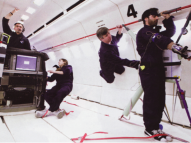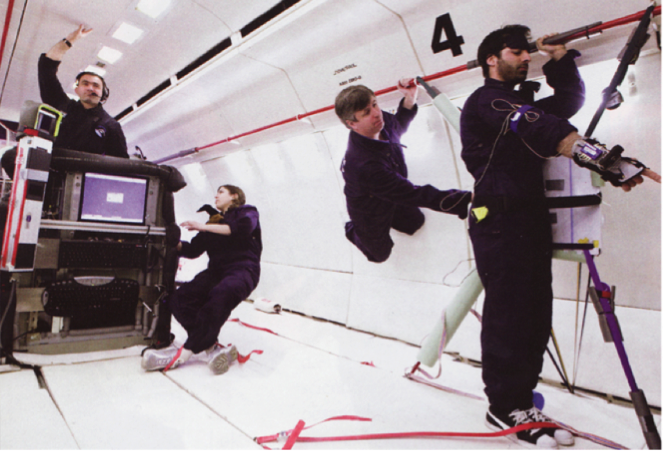I float therefore I am…in space.
Spatial Neurophysiology at the Neuroscience and Cognition Institute (Institut Neurosciences et Cognition)
Linked to the mass of the earth, Gravity is the most important physical data in the evolution of terrestrial species. The human body,and let alone the brain, are adapted to a ‘normal’ gravitational environment, which corresponds to 1 time the weight on earth (1g). On earth, there is a notion of ‘up’ and ‘down’. These intuitive marks, essential for orientation and for motor control, depend on the detection of gravity by the vestibular sensors of the internal ear.
The team Adaptations Sensorimotrices et Pathologies Vestibulaires at INC studies how Earth’s gravity influences the human brain. The team collaborates with ‘Centre National d’Etudes Spatiales’ (CNES) and the European Space Agency (ESA) as well as ‘ Laboratoire Vision Action Cognition’, also part of the INC. Questions on adaptation to altered gravity are at the heart of spatial exploration, which produces successive exposures to different gravity levels: 1g on Earth, 3g at take off, 0g on orbit, but 0,3g on the Moon and on Mars.
One effective way to study the role of this omnipresent and constant force consists in experimenting conditions in which gravity is either changed or absent. For this reason , experiments in psychophysics are led in weightlessness at the international Spatial Station (ISS), or on parabolic flights, which enable short-term exposition to gravity ranging between 0 and 1,8g.
Scientists of the team have shown that, if we ask astronauts in orbit to catch an object thrown towards them, they continue to control their movements using an intrinsic model of terrestrial gravity. This model, which, in normal conditions, allows them to accurately predict the objects’ trajectory, produces some precocious motor responses in microgravity. Only after several days in space does the brain adapt its strategy to predict the lack of acceleration of the object. Other experiments have shown that similar mechanisms are used to control the gripping strenghth on an object, and that, in microgravity, the subjects continue to control grasping reflexes as if the object could fall.
Gravity does not only affect our movements: our perception of the environment is equally affected. As an example, a subject whose task is to visually estimate the width of an opening in weightlessness will underestimate it, compared to what he or she would guess on earth. In the same way, our haptic perception of an object’s dimensions, that are based on touch and proprioception, also depend on gravity. An experiment led by researchers of the team for the French astronaut Thomas Piquets’ next mission on-board International Space Station, will test the hypothesis according to which gravity would influence the brain’s ability to use visual and proprioceptive information to control movements.
To Study long term adaptation to gravity changes on underlying cellular mechanisms, members of the team use a CNES Centrifuge dedicated to the study of rodents (PLEXAN, Université de Saint-Etienne). This machine uses centrifugal force to increase the gravity perceived by an animal of 1 to 4g. Mice are put in rotational cages for weeks in a row. The group observed the effect of hyper-gravity depending upon duration and moment of exposition during development. Our results show that all animals exposed to 2g, including those exposed during their entire development in Centrifuge, were able to readapt to a normal 1g environment. This shows that the vestibular system can develop itself normally in a modified gravitational environment, and that the body can adapt to repeated gravitational changes. An encouraging result in the perspective of long term spatial missions that are planned towards mars and further.


